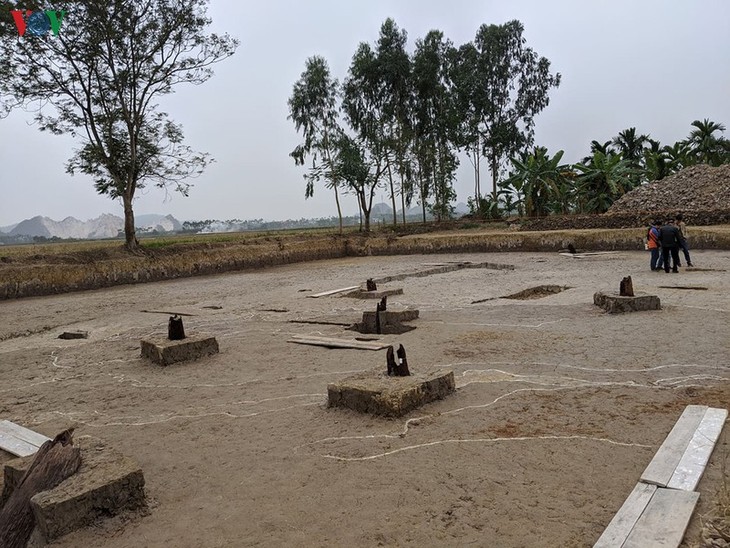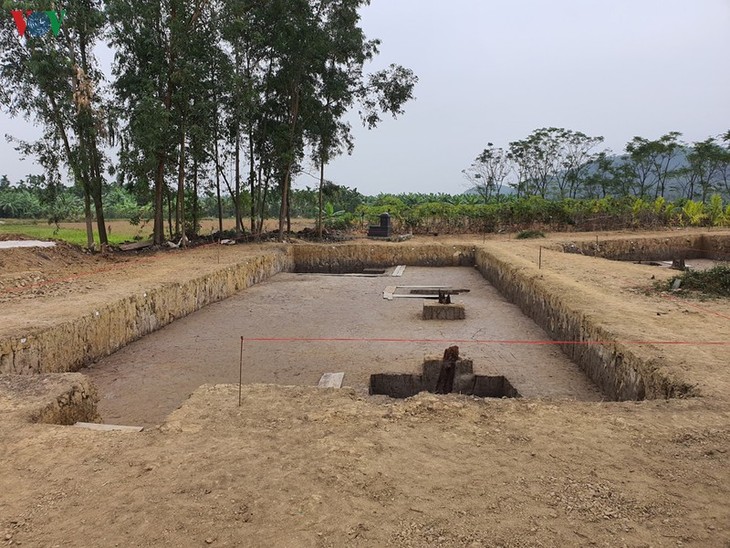(VOVWORLD) - A wooden stake field recently found in Hai Phong city are believed to have been used in the legendary ‘Battle of Bach Dang’ in 1288. The thousand-year-old stakes found in a Cao Quy rice field in Lien Khe commune, Thuy Nguyen district, have prompted new theories about Vietnam’s great victory against the Mongols’ invasion.
27 stakes dating back to the 13th century and 24 ironwood poles have been excavated. The poles are different sizes, staggered positions, and have mortises for attaching ropes.
 The stakes are at staggered positions. The stakes are at staggered positions. |
The rice field is in a filled-up river bed at the junction of the Da Bac and Gia river that leads to the estuary of the Bach Dang river. Scientists have assumed that the Cao Quy stake ground was part of the Bach Dang battlefield the third time the Tran dynasty fought the Mongol invaders. General Tran Hung Dao inspected and selected Cao Quy as a venue for training his soldiers and setting up the stakes. The troops enticed the enemies to follow the Da Bac river to the Bach Dang river and get trapped at Cao Quy. Their boats were punctured by the underwater stakes and sank.
Doctor Le Thi Lien of the Vietnam Institute of Archaeology, said: “The battle involved both soldiers and civilian, under the wise leadership of General Tran Hung Dao. Near the end of the battle, when the tide was low, the stakes emerged. The Mongols’ boats get stuck and tried to land. They got bogged down in the mud and were burned by Vietnamese guerrillas.”
 Cao Quy field where the stakes were found is at the junction of the Da Bac and Gia river. Cao Quy field where the stakes were found is at the junction of the Da Bac and Gia river. |
The discovery of the Cao Quy stake ground confirms that Hai Phong was a major battlefield of the Bach Dang campaign, a really large resistance with which involved a series of battles in several locations. It once was thought that the fighting occurred only in Quang Ninh province.
Professor Doctor Vu Minh Giang, Vice President of the National Heritage Council, told VOV: “The stake ground is located near the Da Bac river. Previous historical research showed that the civilians and soldiers of the Tran dynasty wanted to keep the enemies in the Da Bac river, giving them no chance to escape to the Gia river. A battle took place at the river junction. Our assumption has been proven to be true by the discovery of the Cao Quy stake ground.”
 A total of 24 ironwood poles are excavated in Cao Quy. A total of 24 ironwood poles are excavated in Cao Quy. |
Hai Phong city is working on measures to protect the Cao Quy stake ground and recreate the Bach Dang battle.
Le Van Thanh, General Secretary of the Hai Phong’s Party Committee, told VOV: “Under the guidance of the People’s Committee, Hai Phong City’s Department of Culture and Sports is preparing to recognize the Cao Quy stake ground as a special national relic. Authorities continue to collaborate with the Vietnam Institute of Archeology to inspect a large area from Cao Quy along the Da Bac river to the Bach Dang river to plan the promotion and preservation of the Cao Quy stake ground and other relics in the area.”
The victory in 1288 crushed the Mongols' ambition to conquer all of Southeast Asia and is remembered as one of Vietnam's greatest military victories.